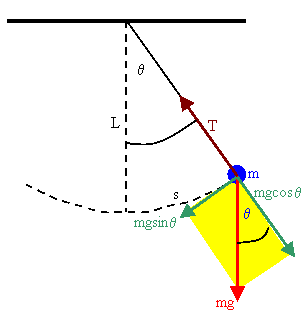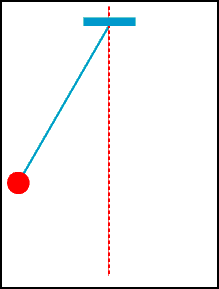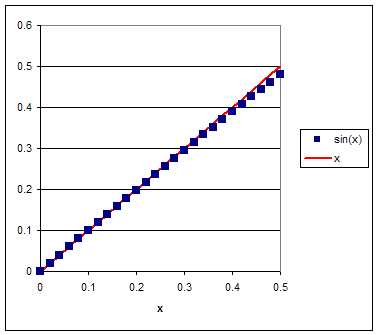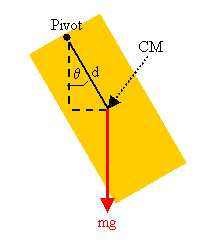Simple harmonic motion:
A = amplitude
T = period
ω = angular frequency
f = frequency
f = 1/T
ω = 2π/T = ω = 2πf
An object whose position as a function of time
varies as
x(t) = Acos(ωt) exhibits simple harmonic motion.
The
velocity of the object as a function of time is given by
v(t) = -ωAsin(ωt), and the acceleration is given by
a(t) = -ω2Acos(ωt) = -ω2x.
F = -kx = mω2x.
ω2 = k/m,
ω = √(k/m), T = 2π√(m/k),
f = (1/2π)√(k/m).
Simple harmonic motion is accelerated motion.
If an object exhibits simple harmonic motion if it is acted on by a restoring force F = -kx, with k = mω2.
A mass oscillating on a spring is an example of an object moving with
simple harmonic motion.
The pendulum:
 Most system which
have an equilibrium position execute simple harmonic motion about this
position when they are displaced from equilibrium, as long as the
displacements are small. The restoring forces approximately obey
Hooke's law. However, for larger displacements the systems become
anharmonic oscillators, i.e. the
restoring forces are no longer proportional to the displacements. The
period then depends on the amplitude. A familiar example of such a
system is the simple pendulum.
Most system which
have an equilibrium position execute simple harmonic motion about this
position when they are displaced from equilibrium, as long as the
displacements are small. The restoring forces approximately obey
Hooke's law. However, for larger displacements the systems become
anharmonic oscillators, i.e. the
restoring forces are no longer proportional to the displacements. The
period then depends on the amplitude. A familiar example of such a
system is the simple pendulum.
 An ideal simple pendulum consists of a point mass m suspended from a
support by a massless string of length L. (A good approximation is a
small mass, for example a sphere with a diameter much smaller than L,
suspended from a light string.) The equilibrium position of the mass is
a distance L below the support. If the mass is displaced from its
equilibrium position while keeping the string taut, it exhibits periodic motion,
moving in a vertical plane along a circular arc.
An ideal simple pendulum consists of a point mass m suspended from a
support by a massless string of length L. (A good approximation is a
small mass, for example a sphere with a diameter much smaller than L,
suspended from a light string.) The equilibrium position of the mass is
a distance L below the support. If the mass is displaced from its
equilibrium position while keeping the string taut, it exhibits periodic motion,
moving in a vertical plane along a circular arc.
When the string makes
an angle θ with the vertical, then the displacement of the mass from its
equilibrium position along the circular arc is s = Lθ. The forces acting
on the mass are gravity and the tension in the string. Only gravity
provides a restoring force towards the equilibrium position. The magnitude
of this force is m g sinθ. The equation of motion, F = ma, therefore
yields
m d2s/dt2 = m g sinθ,
or
d2θ/dt2 = -(g/L) sinθ.
 The solution to this equation describes periodic, but not simple harmonic
motion.
The solution to this equation describes periodic, but not simple harmonic
motion.
However, when the displacement from equilibrium is small, then sinθ
~ θ in radians. (See graph.)
Then the equation of motion becomes
d2θ/dt2 = -(g/L)θ.
The solution to this equation is θ(t) = θmaxcos(ωt
+ φ), with ω2 = g/L.
For small oscillations the period of
a simple pendulum therefore is given by T = 2π/ω = 2π√(L/g).
It is independent of the mass m of the bob. It depends only on the
strength of the gravitational acceleration g and the length of the string L.
By measuring the length and the period of a simple pendulum we can determine
g.
Simple pendulum:
F = -mgsinθ,
s = Lθ.
For small displacements:
F = -mgθ = -(mg/L)s,
k = (mg/L),
ω2 = k/m = g/L,
T = 2π√(L/g), f = 1/T.
We can also write the equation of motion in terms of the displacement s = Lθ.
The net force acting on a simple pendulum bob with mass m is F=
-mgsinθ. It is a restoring force. The displacement from
the equilibrium position is s = Lθ. When the displacement from
equilibrium is small, then sinθ ~ θ in radians. Then F = -mgθ =
-mgs/L.
The force obeys Hooke's law, F = -ks, with k = mg/L.
m d2s/dt2
= -mgs/L, d2s/dt2 = -(g/L)s.
The
pendulum executes simple harmonic motion with ω2 = g/L.
Problem:
The angular displacement of a pendulum is represented by the equation
θ = 0.32*cos(ωt) where θ is in radians and ω = 4.43 rad/s.
Determine the period and length of the pendulum.
Solution:
- Reasoning:
θ(t) = θmaxcos(ωt + φ) for small
oscillations.
- Details of the calculation:
Here ω = 4.43/s, ω2 = g/L = 19.62/s2, L = 0.5 m.
T = 2π/ω = 1.42 s
Problem:
A simple pendulum on a cuckoo clock is 5.00 cm long. What is
its frequency?
Solution:
- Reasoning:
For a simple pendulum ω2 = g/L.
- Details of the calculation:
f = 1/T = ω/(2π) = (g/L)1/2/(2π) = 2.23/s.
Problem:
A simple pendulum with a period of 2.00000 s in one location where g
= 9.80 m/s2 is moved to a new location where the period is
now 1.99796 s. What is the acceleration due to gravity at its new
location?
Solution:
- Reasoning:
For a simple pendulum the period T = 2π)/ω is proportional to 1/g1/2.
- Details of the calculation:
Told/Tnew = (gnew/gold)1/2.
gnew = gold*(Told/Tnew)
= 9.8*(2/1.99796)2 = 9.82 m/s2.
Problem:
Pendulum clocks are made to run at the correct rate by adjusting the
pendulum's length. Suppose you move from one city to another where
the acceleration due to gravity is slightly greater, taking your
pendulum clock with you, will you have to lengthen or shorten the
pendulum to keep the correct time, other factors remaining constant?
Solution:
- Reasoning:
For a simple pendulum the period T is proportional to (L/g)1/2.
If g increases slightly, L has to increase slightly to keep the period the
same. You will have to lengthen the pendulum.
Link: A
simple pendulum
The pendulum wave
Please watch these Youtube videos in lieu of demonstrations.
How does the pendulum wave work?
Assume you have 15 pendulums.
You can choose the period or frequency for each pendulum by choosing its
length. T = 2π(L/g)1/2, f = (1/2π)(g/L)1/2.
A shorter length corresponds to a higher frequency.
Example:
Chose the length of the longest pendulum so that its frequency is f = 52/min.
Make the next pendulum slightly shorter, so its frequency is f = 53/min.
Continue to make the pendulums shorter so that their frequencies become 54/min,
55/min, ..., 66/min.
(The 15th pendulum has a frequency of (52 + 14)/min = 66/min.)
After 1 minute all pendulums have completed an integer number of oscillations
and returned to their initial position.
 A physical pendulum is an object suspended in a
uniform gravitational field from a point other than its center of mass. The object can
rotate about an axis through the suspension point. When the CM is displaced from its
stable equilibrium point under the support, the gravitational force exerts a torque about
the support, resulting in angular acceleration. The CM accelerates towards its equilibrium
position. The object exhibits periodic motion. For small displacements, when sinθ ~ θ, the motion is simple harmonic, θ(t) = θmaxcos(ωt +
φ),
with ω2 = (mgd)/I and the equilibrium
position chosen to be zero. Here I is the moment of inertia of
the object about the axis of rotation through the support and d is the perpendicular
distance of the CM from the axis of rotation through the support.
A physical pendulum is an object suspended in a
uniform gravitational field from a point other than its center of mass. The object can
rotate about an axis through the suspension point. When the CM is displaced from its
stable equilibrium point under the support, the gravitational force exerts a torque about
the support, resulting in angular acceleration. The CM accelerates towards its equilibrium
position. The object exhibits periodic motion. For small displacements, when sinθ ~ θ, the motion is simple harmonic, θ(t) = θmaxcos(ωt +
φ),
with ω2 = (mgd)/I and the equilibrium
position chosen to be zero. Here I is the moment of inertia of
the object about the axis of rotation through the support and d is the perpendicular
distance of the CM from the axis of rotation through the support.
 Most system which
have an equilibrium position execute simple harmonic motion about this
position when they are displaced from equilibrium, as long as the
displacements are small. The restoring forces approximately obey
Hooke's law. However, for larger displacements the systems become
anharmonic oscillators, i.e. the
restoring forces are no longer proportional to the displacements. The
period then depends on the amplitude. A familiar example of such a
system is the simple pendulum.
Most system which
have an equilibrium position execute simple harmonic motion about this
position when they are displaced from equilibrium, as long as the
displacements are small. The restoring forces approximately obey
Hooke's law. However, for larger displacements the systems become
anharmonic oscillators, i.e. the
restoring forces are no longer proportional to the displacements. The
period then depends on the amplitude. A familiar example of such a
system is the simple pendulum. An ideal simple pendulum consists of a point mass m suspended from a
support by a massless string of length L. (A good approximation is a
small mass, for example a sphere with a diameter much smaller than L,
suspended from a light string.) The equilibrium position of the mass is
a distance L below the support. If the mass is displaced from its
equilibrium position while keeping the string taut, it exhibits periodic motion,
moving in a vertical plane along a circular arc.
An ideal simple pendulum consists of a point mass m suspended from a
support by a massless string of length L. (A good approximation is a
small mass, for example a sphere with a diameter much smaller than L,
suspended from a light string.) The equilibrium position of the mass is
a distance L below the support. If the mass is displaced from its
equilibrium position while keeping the string taut, it exhibits periodic motion,
moving in a vertical plane along a circular arc.  The solution to this equation describes periodic, but not simple harmonic
motion.
The solution to this equation describes periodic, but not simple harmonic
motion. A physical pendulum is an object suspended in a
uniform gravitational field from a point other than its center of mass. The object can
rotate about an axis through the suspension point. When the CM is displaced from its
stable equilibrium point under the support, the gravitational force exerts a torque about
the support, resulting in angular acceleration. The CM accelerates towards its equilibrium
position. The object exhibits periodic motion. For small displacements, when sinθ ~ θ, the motion is simple harmonic, θ(t) = θmaxcos(ωt +
φ),
with ω2 = (mgd)/I and the equilibrium
position chosen to be zero. Here I is the moment of inertia of
the object about the axis of rotation through the support and d is the perpendicular
distance of the CM from the axis of rotation through the support.
A physical pendulum is an object suspended in a
uniform gravitational field from a point other than its center of mass. The object can
rotate about an axis through the suspension point. When the CM is displaced from its
stable equilibrium point under the support, the gravitational force exerts a torque about
the support, resulting in angular acceleration. The CM accelerates towards its equilibrium
position. The object exhibits periodic motion. For small displacements, when sinθ ~ θ, the motion is simple harmonic, θ(t) = θmaxcos(ωt +
φ),
with ω2 = (mgd)/I and the equilibrium
position chosen to be zero. Here I is the moment of inertia of
the object about the axis of rotation through the support and d is the perpendicular
distance of the CM from the axis of rotation through the support.